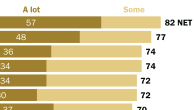This statistical profile provides key demographic information of Latino eligible voters in Florida.1 It also contains data on other major groups of eligible voters in Florida.2 All data are based on Pew Hispanic Center tabulations of the Census Bureau’s 2008 American Community Survey.3
Hispanics in Florida’s Eligible Voter Population
- The Hispanic population in Florida is the third-largest in the nation. More than 3.8 million Hispanics reside in Florida, 8% of all Hispanics in the United States.
- The population in Florida is 21% Hispanic, the sixth-highest Hispanic population share nationally.
- There are 1.8 million eligible Hispanic voters in Florida—the third-largest Hispanic eligible-voter population nationally. California ranks first with 5.4 million.
- Some 15% of eligible voters in Florida are Latinos, the fifth-largest Hispanic eligible voter population share nationally. New Mexico ranks first with 38%.
- One-half (48%) of Latinos in Florida are eligible to vote, ranking Florida 13th nationwide in the share of the Hispanic population that is eligible to vote. In contrast, 80% of the state’s white population is eligible to vote.

Characteristics of Eligible Voters
- Age. Florida’s Hispanic eligible voters are younger than all eligible voters in Florida—23% of Hispanic eligible voters in Florida are ages 18 to 29 versus 19% of all Florida eligible voters.
- Citizenship. Some 44% of Hispanic eligible voters in Florida are naturalized U.S. citizens, compared with 12% of all Florida eligible voters. Hispanic eligible voters in Florida are less likely to be native-born citizens (56%) than are Hispanic eligible voters nationwide (74%).
- Educational Attainment. Two-in-ten of Latino eligible voters in Florida (21%) have not completed high school. That was less than the rate for all Latino eligible voters—26%—but greater than the rate for U.S. eligible voters nationwide—13%.
- Homeownership. Two-thirds of Hispanic eligible voters in Florida (68%) live in owner-occupied homes, compared with 60% of all Hispanic eligible voters nationwide. Somewhat greater shares of all eligible voters in Florida (72%) and all eligible voters nationwide (70%) live in owner-occupied
homes.

Characteristics of Eligible Voters in Florida, by Race and Ethnicity
- Number of Latino Eligible Voters. White eligible voters outnumber Hispanic and black eligible voters in Florida by more than 4 to 1.
- Age. Black eligible voters are younger than Hispanic or white eligible voters in Florida—28% of black eligible voters are ages 18 to 29 compared with 23% of Hispanic and 16% of white eligible voters.
- Educational Attainment. Hispanic eligible voters in Florida are more likely than blacks, but less likely than whites, to have attended college or earned at least a bachelor’s degree—51% of Hispanic eligible voters have attended college or earned at least a bachelor’s degree compared with 59% of white and 45% of black eligible voters.
- Homeownership. Hispanic eligible voters are less likely than white eligible voters in Florida to live in owner-occupied homes—68% versus 77%.






